

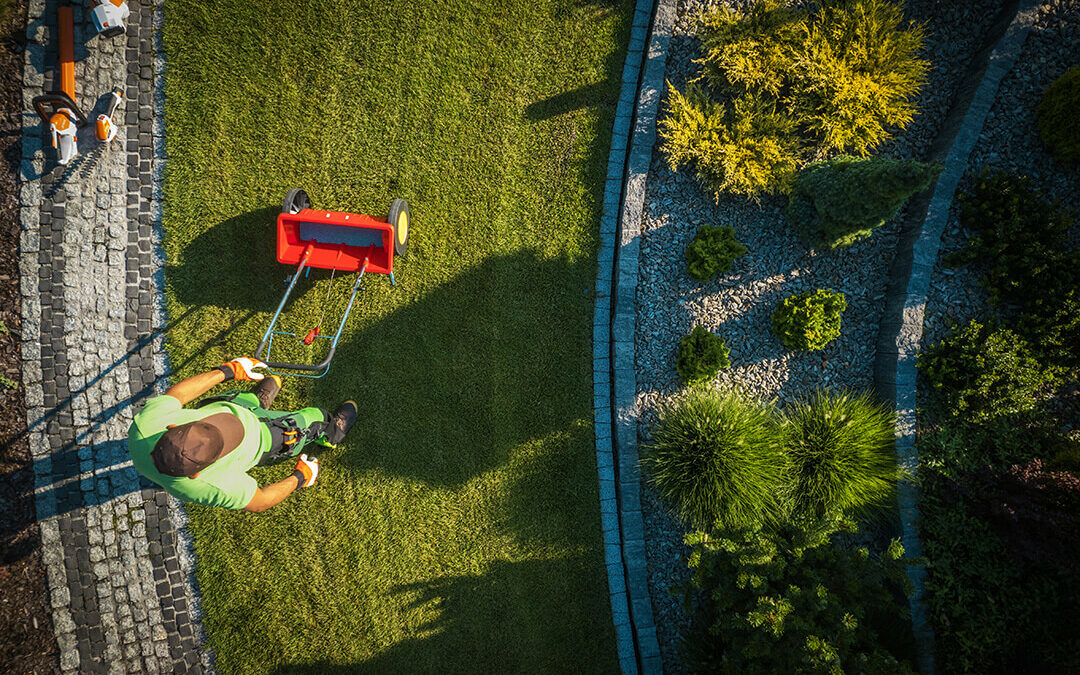
Seed or Sod – Which Is Best for Your Lawn?
Creating and maintaining a lush, green lawn is the goal of many homeowners. Because of the maintenance required to keep grass looking its best, some may opt to reduce total lawn area by adding hardscaping, softscaping, and xeriscaping. But, for those who love a verdant lawn, achieving it often comes down to a fundamental decision: seed or sod?
Both methods have their advantages and differences, and understanding them can help you make the best choice for your lawn. In this post, we’ll explore the pros and cons of seeding and sodding, as well as discuss the most suitable grass varieties for our region’s hardiness zones (5/6).
Seed or Sod – The Benefits of Grass Seed
 Seeding involves planting grass seed directly into the soil and allowing it to grow and establish over time. Here are some advantages of seeding:
Seeding involves planting grass seed directly into the soil and allowing it to grow and establish over time. Here are some advantages of seeding:
Cost-Effectiveness
Seeding is generally more budget-friendly than sodding, making it an attractive option for those looking to save money.
Variety
Seeding allows for a wider selection of grass varieties, including blends tailored to specific soil types, sunlight levels, and climate conditions.
Adaptability
Seeded lawns tend to develop deeper root systems, which can make them more resilient to drought and environmental stress over time.
However, seeding also has its drawbacks. It typically takes longer for seeded lawns to establish, requiring regular watering and maintenance during the germination period. Additionally, there’s a risk of erosion or soil disturbance before the grass becomes fully established.
Seed or Sod – The Benefits of Sod
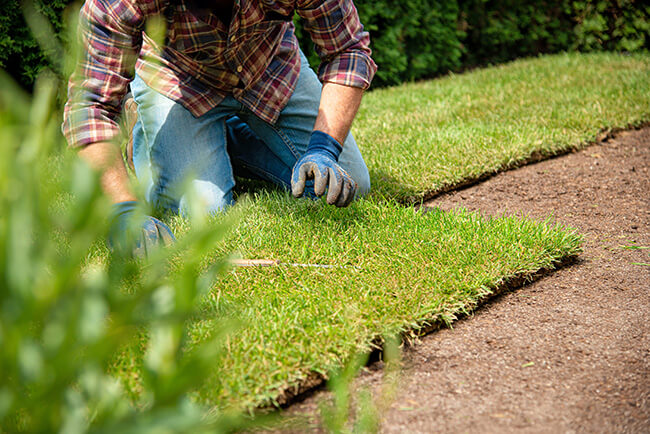 Sodding involves laying down pre-grown grass turf, complete with roots and soil, onto prepared soil. Here are some advantages of sodding:
Sodding involves laying down pre-grown grass turf, complete with roots and soil, onto prepared soil. Here are some advantages of sodding:
Instant Results
Sodding provides an instant lawn, with immediate coverage and a mature appearance. This makes it a popular choice for homeowners who want immediate results or have limited time for lawn care.
Erosion Control
Sodding helps prevent soil erosion, making it an excellent choice for sloped or vulnerable areas of the landscape.
Weed Suppression
Sodding can help suppress weed growth, as the dense turf outcompetes many weed species.
However, sodding is generally more expensive than seeding, and the selection of grass varieties may be limited compared to seeding options. Additionally, improper installation or care can lead to issues such as uneven settling or root detachment.
Grass Varieties for Hardiness Zones 5 and 6
In hardiness zones 5 and 6, which encompass regions with cold winters and moderate summers, several grass varieties thrive. For seeding, popular options include:
Kentucky Bluegrass
Known for its fine texture and deep blue-green colour, Kentucky bluegrass is well-suited to cooler climates and is often included in seed blends for its durability and attractive appearance.
Perennial Ryegrass
Perennial ryegrass is quick to establish and offers excellent wear tolerance, making it suitable for high-traffic areas.
Fine Fescue
Fine fescue varieties, such as creeping red fescue or Chewings fescue, are shade-tolerant and low-maintenance options for areas with limited sunlight.
For sodding, blends of Kentucky bluegrass and fine fescue are commonly used due to their adaptability and resilience.
Both seeding and sodding offer distinct advantages for establishing a healthy lawn. Seeding is cost-effective and allows for a wider range of grass varieties, while sodding provides instant results and helps prevent soil erosion. Ultimately, the best choice depends on factors such as budget, time constraints, and personal preferences. By selecting the right method and grass varieties for your specific needs, you can enjoy a vibrant, beautiful lawn for years to come.
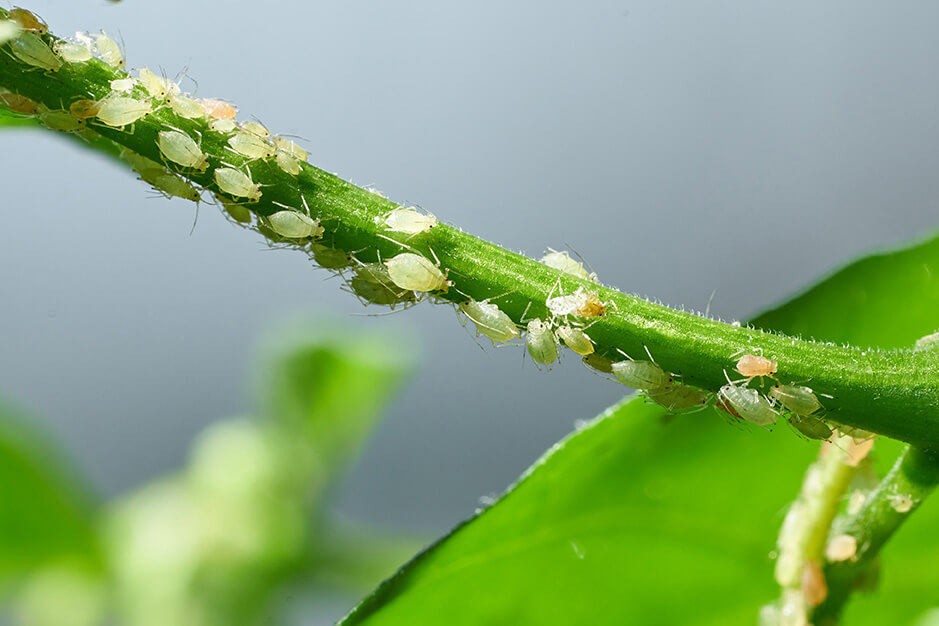
Common Lawn and Garden Pests
Spring has arrived and green is overtaking white. However, the growing season is accompanied by pests who like to feast on our landscapes. Below, we’ll shed light on some of the most common lawn and garden pests in Southwestern Ontario – their origins, identification, prevention, and management strategies.
Japanese Beetles (Popillia japonica)
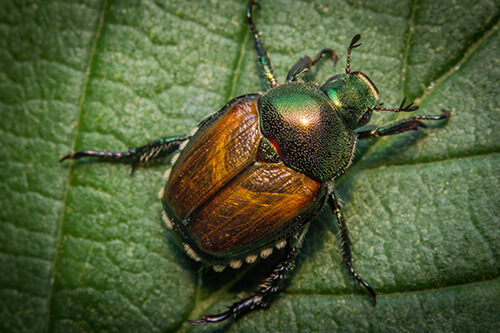 Japanese beetles were introduced from Japan in the early 20th century and have since made themselves at home in Southwestern Ontario. These beetles have a metallic green color with copper-colored wings and are often found munching on the leaves of roses, grapes, and fruit trees.
Japanese beetles were introduced from Japan in the early 20th century and have since made themselves at home in Southwestern Ontario. These beetles have a metallic green color with copper-colored wings and are often found munching on the leaves of roses, grapes, and fruit trees.
Control Methods
- Handpick the beetles
- Use row covers
- Apply insecticidal soap or neem oil
- Introduce beneficial nematodes to target the larvae
Dealing with Damage
Prune damaged foliage and promote plant health through proper care.
Aphids (Aphidoidea)
 Aphids are native to North America and thrive in our temperate climate, reproducing rapidly and infesting a wide range of plants. This makes Aphids one of the most common among the common lawn and garden pests in our region. Look for clusters of small, green, pear-shaped insects on plant stems and new growth of various garden plants, including roses, vegetables, and fruit trees.
Aphids are native to North America and thrive in our temperate climate, reproducing rapidly and infesting a wide range of plants. This makes Aphids one of the most common among the common lawn and garden pests in our region. Look for clusters of small, green, pear-shaped insects on plant stems and new growth of various garden plants, including roses, vegetables, and fruit trees.
Control Methods
- Encourage natural predators such as ladybugs and lacewings
- Use insecticidal soap or neem oil, and blast aphids off plants with a strong stream of water.
Dealing with Damage
Prune heavily infested areas and monitor plant recovery.
Emerald Ash Borer (Agrilus planipennis)
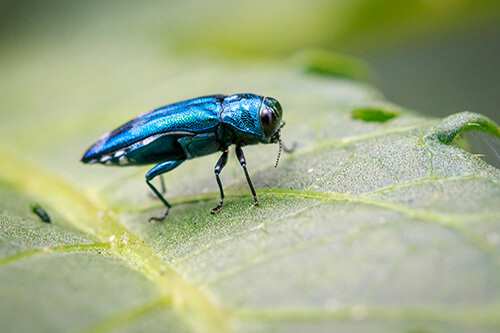 Native to Asia, emerald ash borers arrived in North America in the early 2000s and have devastated ash tree populations. Look for D-shaped exit holes in ash tree bark, canopy dieback, and S-shaped larval galleries under the bark.
Native to Asia, emerald ash borers arrived in North America in the early 2000s and have devastated ash tree populations. Look for D-shaped exit holes in ash tree bark, canopy dieback, and S-shaped larval galleries under the bark.
Control Methods
- Implement preventive treatments such as trunk injections with systemic insecticides
- Consider replacing susceptible ash trees with resistant species.
Dealing with Damage
Prune dead branches and monitor remaining ash trees for signs of infestation.
Spider Mites (Tetranychidae)
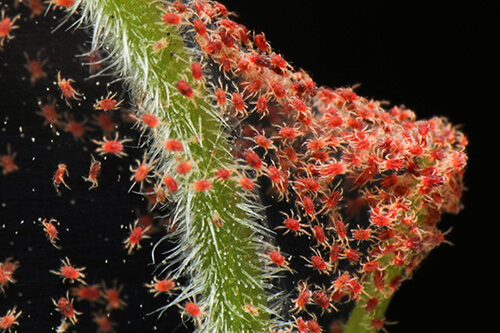 Spider mites are native to North America and thrive in warm, dry conditions, rapidly infesting plants. Look for fine webbing on the undersides of leaves and stippling or discoloration on foliage of garden plants, including tomatoes, beans, and ornamentals.
Spider mites are native to North America and thrive in warm, dry conditions, rapidly infesting plants. Look for fine webbing on the undersides of leaves and stippling or discoloration on foliage of garden plants, including tomatoes, beans, and ornamentals.
Control Methods
- Increase humidity around plants
- Introduce predatory mites or insects
- Apply horticultural oil or insecticidal soap
Dealing with Damage
Trim away heavily infested foliage and monitor plant recovery.
White Grubs (Scarabaeidae larvae)
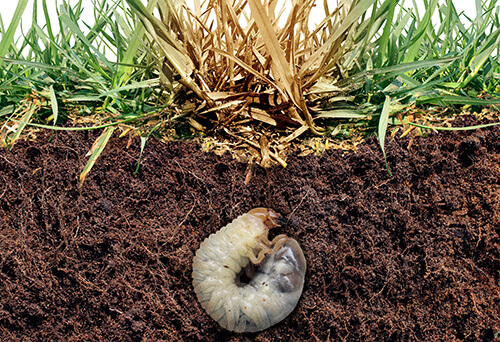 These soil-dwelling larvae are the immature stage of beetles like Japanese beetles, and they primarily feed on grass roots. Look for patches of dead or dying grass, which may indicate white grub infestation.
These soil-dwelling larvae are the immature stage of beetles like Japanese beetles, and they primarily feed on grass roots. Look for patches of dead or dying grass, which may indicate white grub infestation.
Control Methods
- Use beneficial nematodes or milky spore disease to target grubs in the soil
Dealing with Damage
Re-seed affected areas and maintain proper lawn care practices.
Cutworms (Noctuidae larvae)
 Cutworms are native to North America and are nocturnal pests that feed on young seedlings at or below ground level. Look for seedlings that have been cut off at the base.
Cutworms are native to North America and are nocturnal pests that feed on young seedlings at or below ground level. Look for seedlings that have been cut off at the base.
Control Methods
- Use collar barriers around seedlings
- Handpick cutworks from plants
- Apply biological controls
Dealing with Damage
Replant damaged seedlings and protect them from future attacks.
Slugs and Snails (Gastropoda)
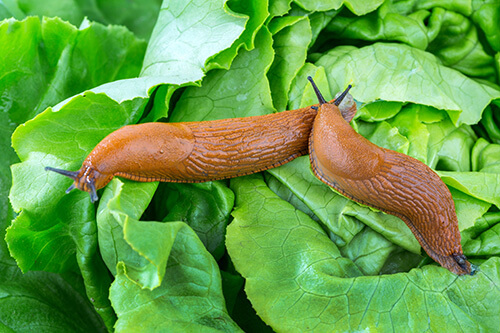 Slugs and snails are native to the region and are nocturnal pests that feed on plant foliage and tender shoots of a range of garden plants. Follow slime trails and look for irregular holes in leaves.
Slugs and snails are native to the region and are nocturnal pests that feed on plant foliage and tender shoots of a range of garden plants. Follow slime trails and look for irregular holes in leaves.
Control Methods
- Set up beer traps
- Apply diatomaceous earth
- Handpick them off of plants
- Introduce natural predators like toads and birds
Dealing with Damage
Trim away damaged foliage and keep garden areas clean and tidy.
Cabbage Worms (Pieris rapae)
 Cabbage worms are native to North America and are the larval stage of small white butterflies. As their name implies, they feed on brassica crops. Look for green caterpillars on cabbage family plants (cabbage, broccoli, kale), causing chewing damage to leaves.
Cabbage worms are native to North America and are the larval stage of small white butterflies. As their name implies, they feed on brassica crops. Look for green caterpillars on cabbage family plants (cabbage, broccoli, kale), causing chewing damage to leaves.
Control Methods
- Handpick caterpillars
- Use floating row covers
- Apply Bacillus thuringiensis (Bt)
- Encourage natural predators
Dealing with Damage
Trim away damaged leaves and protect plants from future infestations.
Thrips (Thysanoptera)
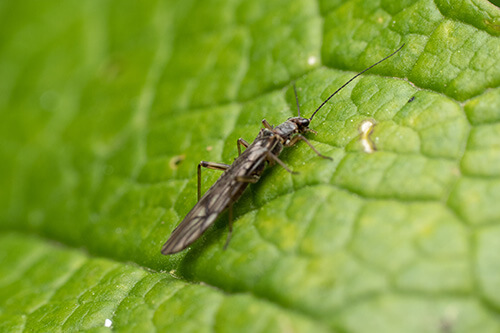 Thrips are native insects that feed on the sap of garden plants, including roses, onions, and peppers. They can transmit diseases to a wide range of plants. Look for tiny, slender insects and silvery patches on leaves.
Thrips are native insects that feed on the sap of garden plants, including roses, onions, and peppers. They can transmit diseases to a wide range of plants. Look for tiny, slender insects and silvery patches on leaves.
Control Methods
- Use insecticidal soap or neem oil
- Introduce predatory insects
Dealing with Damage
Trim away damaged foliage and monitor plant health.
Scale Insects (Coccoidea)
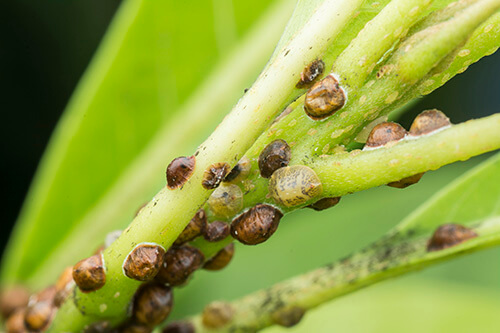 Scale insects are native to North America and can weaken or kill plants by feeding on sap and excreting honeydew of ornamental and fruit-bearing trees. Look for small, immobile insects on stems and leaves, often surrounded by a protective shell.
Scale insects are native to North America and can weaken or kill plants by feeding on sap and excreting honeydew of ornamental and fruit-bearing trees. Look for small, immobile insects on stems and leaves, often surrounded by a protective shell.
Control Methods
- Use horticultural oil or insecticidal soap
- Introduce natural enemies like ladybugs
Dealing with Damage
Prune away heavily infested branches and monitor plant recovery.
This guide will help prepare you to identify and combat common lawn and garden pests in Southwestern Ontario. Remember to stay vigilant, implement preventive measures, and maintain overall plant health to keep those pesky critters at bay.
Pest control product mentioned above – insecticidal soap, diatomaceous earth, neem oil, nematodes, collar barriers, floating row covers – are available at local garden centres. When purchasing, talk to staff about proper application/use for optimal effectiveness.
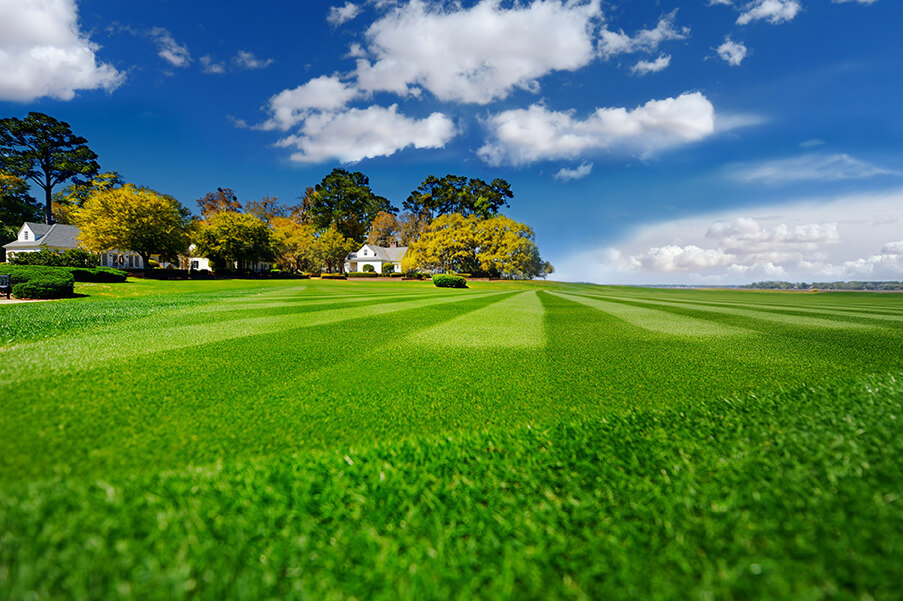
Mow Your Lawn Like A Pro
A lush, well-maintained lawn can significantly enhance the curb appeal of your home and provide a beautiful outdoor space for relaxation and recreation. If you want your lawn to look like it’s professionally groomed and prefer to do it yourself, the following tips might be all you need to mow your lawn like a pro. Here’s how to mow your lawn like a pro to achieve a perfectly manicured lawn that will be the envy of your neighborhood.
Tips and Techniques for a Perfectly Manicured Yard
Choose the Right Equipment
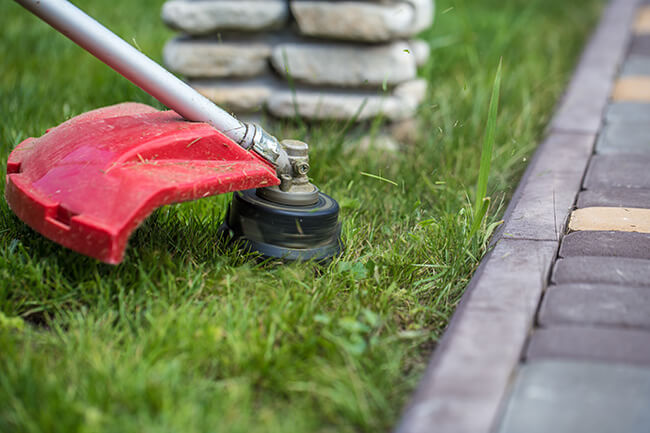 Investing in quality lawn care equipment is essential to achieve professional results. A sturdy lawnmower with sharp blades is a must. Whether you prefer a traditional gas-powered mower or an eco-friendly electric one, make sure it suits the size and terrain of your lawn. Additionally, consider acquiring a string trimmer, also known as an edger, for detailing and reaching areas that the lawnmower can’t easily access.
Investing in quality lawn care equipment is essential to achieve professional results. A sturdy lawnmower with sharp blades is a must. Whether you prefer a traditional gas-powered mower or an eco-friendly electric one, make sure it suits the size and terrain of your lawn. Additionally, consider acquiring a string trimmer, also known as an edger, for detailing and reaching areas that the lawnmower can’t easily access.
Regular Maintenance
Consistent maintenance is key to a perfectly manicured lawn. Set a schedule for cutting your grass, typically once to twice a week during the growing season, depending on the type of grass and weather conditions. Regular mowing helps to promote healthy grass growth and prevents the lawn from becoming overgrown.
Avoid Cutting Grass Too Short
One common mistake is cutting grass too short. Mowing your lawn too low can put undue stress on soil and your lawn’s root system, leaving it vulnerable to pests, diseases, and weed invasion. A general rule of thumb is to never remove more than one-third of the grass height in a single mowing session. Opt for a higher setting on your lawnmower (2.5” to 3”), particularly during the hot summer months, as longer grass blades provide shade to the soil, retaining moisture and preventing weed growth. At the end of growing season, lower your blade to 2” for a shorter cut to prevent small rodents from overwintering in your grass.
Mow with a Pattern
Professionals often mow in a different pattern each time to prevent grass from leaning in one direction and create a more uniform look. Alternate between horizontal, vertical, and diagonal mowing patterns to avoid compaction and achieve a cleaner cut.
Keep Blades Sharp
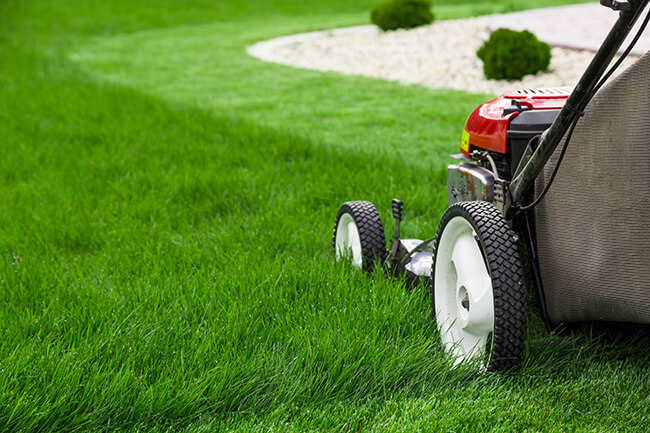 Dull mower blades tear the grass rather than cutting it cleanly. This can lead to a brownish, uneven appearance on the lawn’s surface. Regularly sharpen your lawnmower blades to ensure a precise and neat cut, enhancing the overall aesthetics of your lawn. A few times a year, you can use mulching blades on your mower. These blades will chop or cut the clippings in smaller pieces to make it easier for them to decompose.
Dull mower blades tear the grass rather than cutting it cleanly. This can lead to a brownish, uneven appearance on the lawn’s surface. Regularly sharpen your lawnmower blades to ensure a precise and neat cut, enhancing the overall aesthetics of your lawn. A few times a year, you can use mulching blades on your mower. These blades will chop or cut the clippings in smaller pieces to make it easier for them to decompose.
Trim and Edge
For a professional finish, pay attention to the details. Use a string trimmer as an edger to create distinct boundaries between the lawn and other elements like a patio, driveway, flowerbeds, and walkways. Edging adds a polished touch to your yard.
Mind the Weather
Avoid mowing the lawn when it’s wet, as wet grass is more likely to clump and clog the lawnmower. Additionally, mowing wet grass can cause uneven cuts and damage the turf. Aim to mow during the cooler parts of the day, preferably early morning or late afternoon, to reduce stress on the grass.
Clean Up After Mowing
Finally, after you’ve finished mowing, take a few extra minutes to clean up the lawn. Remove any grass clippings and debris left behind. This will not only make your lawn look neater but also prevent clippings forming “thatch” which can smother the grass and block sunlight.
By following these expert tips to mow your lawn like a pro, you can transform your lawn into a professionally manicured masterpiece. Remember that patience and consistent care are the keys to success. With time and practice, you’ll become a lawn-cutting expert. If you want the professional look without the work, contact us to discuss a maintenance plan.

Keep Unwanted Wildlife Out of Your Backyard
Last month, we shared tips for attracting wildlife to your backyard. Well, we recognize that not all wildlife is welcome on your property. So, this month we’re sharing tips for keeping unwanted wildlife away.
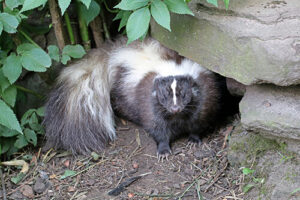 Keeping rodent pests like raccoons and skunks out of your backyard can sometimes be a difficult task, but with the right landscaping strategies you can discourage them from visiting. Strategies include lawn maintenance, careful selection of plants, trees, and shrubs, and adding hardscaping to block or discourage entry into your outdoor space. Read on for more details.
Keeping rodent pests like raccoons and skunks out of your backyard can sometimes be a difficult task, but with the right landscaping strategies you can discourage them from visiting. Strategies include lawn maintenance, careful selection of plants, trees, and shrubs, and adding hardscaping to block or discourage entry into your outdoor space. Read on for more details.
Lawn Maintenance
Keeping your lawn mowed to two to three inches high and free of debris, such as leaves, sticks, or logs, can help discourage pesky critters from making their homes in it. Additionally, leaving a perimeter of uncut grass around the edges of your property can act as a barrier to keep them away from the rest of your yard.
Lawn Health
 An unhealthy lawn’s root system is a breeding ground for weeds that unwelcome pests may feed on. And your lawn’s poor health may be an indication of an excess number of parasites (like grubs) that skunks and raccoons also find delectable. If your lawn has seen better days, don’t despair. Foundational lawn care practices like aeration, fertilization, and top dressing can help restore your lawn’s vitality. One or more applications of nematodes can help get grub populations under control again, as well.
An unhealthy lawn’s root system is a breeding ground for weeds that unwelcome pests may feed on. And your lawn’s poor health may be an indication of an excess number of parasites (like grubs) that skunks and raccoons also find delectable. If your lawn has seen better days, don’t despair. Foundational lawn care practices like aeration, fertilization, and top dressing can help restore your lawn’s vitality. One or more applications of nematodes can help get grub populations under control again, as well.
Plant Selection and Placement
Choosing plants that are not appealing to unwanted wildlife is key when trying to keep them out of your backyard. Thorny shrubs and prickly evergreens like Scotch Pine make great deterrents since animals can’t generally navigate through them easily. Additionally, you should avoid placing wood piles or compost heaps near the edge of your property as they often attract rodents.
Hardscaping
Installing hardscaping features like garden fences and retaining walls can help keep pests away due to their height and lack of access points for small critters. If you don’t want to install a fence or wall, landscape fabric may be an option. When laid beneath a layer of mulch it provides a strong physical barrier that prevents most pests from digging into your yard.
Food Sources
 Reduce or eliminate food sources that may be attracting unwanted wildlife to your property. This includes pet food dishes, bird feeders, fruit bearing trees and shrubs, and unsecured garbage cans. Rabbits and mice like to feed on the bark of younger shrubs and trees. To prevent this, install a guard or fabric around the trunks of younger shrubs/trees during the winter months to prevent this from happening.
Reduce or eliminate food sources that may be attracting unwanted wildlife to your property. This includes pet food dishes, bird feeders, fruit bearing trees and shrubs, and unsecured garbage cans. Rabbits and mice like to feed on the bark of younger shrubs and trees. To prevent this, install a guard or fabric around the trunks of younger shrubs/trees during the winter months to prevent this from happening.
Barriers
Installing a chicken wire type barrier around the perimeter of your property or gardens between the bottom of your fence and the soil/lawn and digging it in a few inches into the ground will deter or prevent smaller animals from entering your gardens.
Compromise
Even with the best efforts, unwanted animals will sometimes still be able to enter your gardens or lawn areas. Since your gardens/lawn are their main food source, you might have to share some of your plants with these creatures. A garden or plants do not always have to look perfect if you lose a plant or two during the winter months, replace it with something that may be more of a deterrent or protect it during the winter months.
Additional Tip
If you notice there is a particular plant that is attracting pests, try to replace it with something else that won’t be as enticing. This will help reduce the number of rodents on your property and make your outdoor space less appealing to unwanted guests overall.
Although some of our readers are very capable DIYers, we recognize that others may need assistance with the implementation of the above pest-thwarting strategies. If you fit into the latter category, don’t hesitate to contact us for professional landscaping advice and assistance!
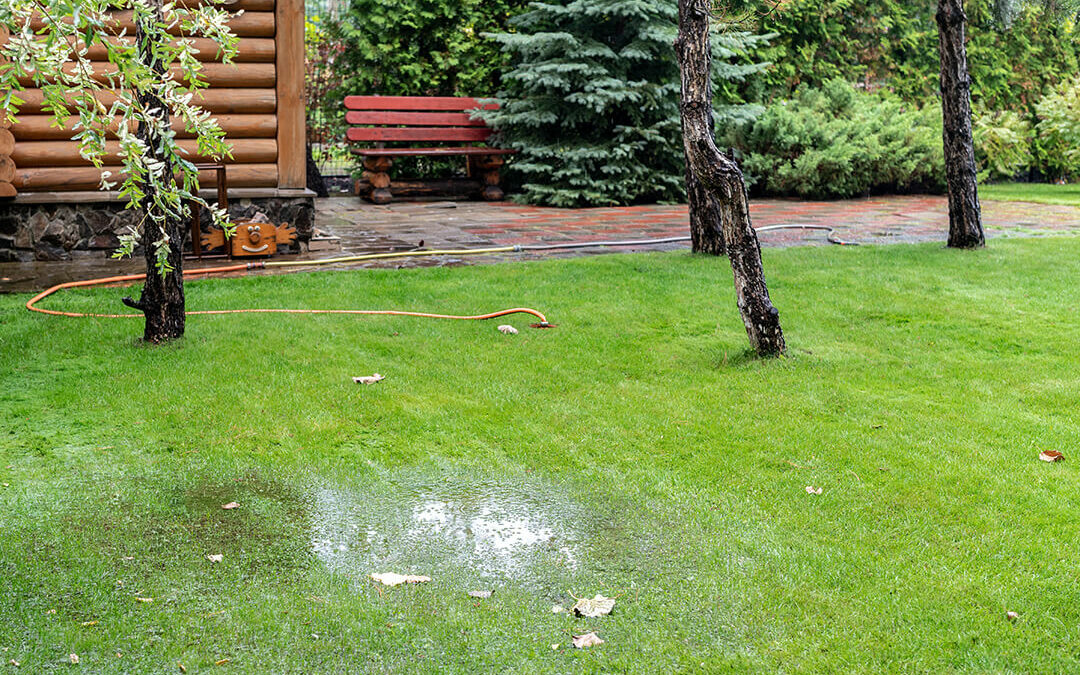
Improve drainage in your lawn and garden
At one time or another, many homeowners will encounter issues with poor draining soil. This can lead to flooding of patios, gardens, and low-lying or high-traffic grassy areas.
Stratford and area, in particular, has predominantly clay-based soils, making drainage problematic from the outset.
But not to fear, there are various solutions – some simple, some more complex – to your drainage woes.

Improve Drainage
Gardens
Mix in compost or sand. These materials have larger particles than clay, so incorporating them into the soil will create space for drainage. Just ensure that you mix the added materials in well – ideally by rototilling – to prevent layers from forming.
Lawns
If water pools in one or more areas of your lawn, the best strategy is to add drain tile. It’s a bit laborious (and potentially something you’ll want to outsource), but will be effective in eliminating standing water from your yard.
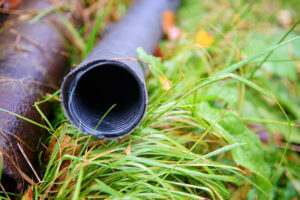
Use a 4” perforated drain tile, either (with or without a sock) and lay it in an 8 to 10-inch deep and 12-inch wide trench in the ground. Backfill around tile with a sandy loam soil that will help facilitate drainage of excess water into the tile.
If possible, extend the tile to an area where the water can run off your property. If that’s not possible, create a 3’ x3’ x3’ pit filled with ¾ clear stone where the tile can drain into and the water can disperse into the lower soil levels.
The top 4 to 6 inches of the trench should be filled with good quality top soil to ensure some water is retained to nourish grass, preventing the lawn from drying out during dry periods.
Patios
Patio areas, especially older ones or those that were poorly constructed, may fall prey to standing water. This can make the patio unusable until the surface either drains by itself or is cleared with a broom or squeegee.
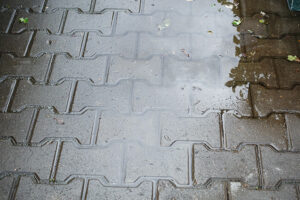
Standing water on stone surfaces can also lead to mossy growth, which is both slippery and unsightly. Prolonged pooling water can also negatively affect your home’s foundation and may even seep inside your basement.
The best solution to an ill-draining patio is to remove all stones and increase the level of the patio’s foundation by adding several inches of well-draining aggregate. In addition, it’s important to ensure that the patio has a slight slope away from the house, so that the water can drain freely and without risk of harming adjacent structures.
High-Traffic Areas
Some grassy areas serve as throughways (from the front to the back yard, for example). Many homeowners, especially owners of newer homes find that their side property lines shared with neighbours become tough to navigate due to standing water in wet conditions.
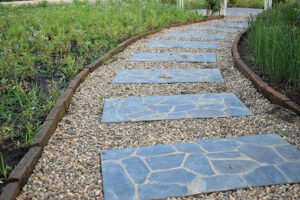
With houses being built closer together these days, new home owners may also find that plants and grass grow unpredictably or inconsistently due to lack of sufficient sunlight. When you add that to the fact that side yards are generally not used or seen by many, it’s not surprising that many look to a low-maintenance option to address all of these issues at once.
The most common solution is the installation of perforated drain tile, keeping with the original slope/grade of the property (typically back-to-front). Once the drain tile is installed and the trench backfilled, the area is finished with a combination of river rock and slabs to achieve a result that is navigable, well-draining, nice-looking, and low-maintenance.
Work with Wet Conditions
Of course, instead of fighting standing water, and assuming the issue isn’t too pervasive, there is a way you can work with the situation.
Choose moisture-loving plants and trees
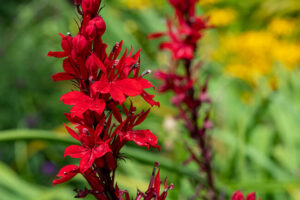 Just as some plants and trees flourish with more or less light than others, they all have varying tolerances of moisture. Choosing varieties that can tolerate slower-draining conditions will relieve you of what could otherwise be a ongoing battle. Ideally, you’ll still want to add some well-draining material to the soil to avoid plants having perpetually wet “feet”.
Just as some plants and trees flourish with more or less light than others, they all have varying tolerances of moisture. Choosing varieties that can tolerate slower-draining conditions will relieve you of what could otherwise be a ongoing battle. Ideally, you’ll still want to add some well-draining material to the soil to avoid plants having perpetually wet “feet”.
Some of these solutions are easier to implement on your own than others. If or when you reach the end of your capabilities and want the job done quickly and properly, give us a call. We regularly included drainage improvement measures in our landscaping projects and would be happy to help.
